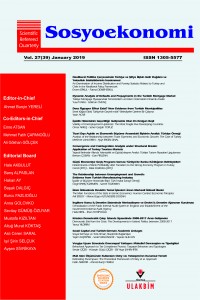Öz
Bu çalışmada mali alan ölçüm yöntemlerinden birisi olan Ostry vd. yaklaşımının kuramsal temelinin incelenmesi amaçlanmıştır. Bu doğrultuda yaklaşımın dayandırıldığı varsayımlar başta olmak üzere “mali yorgunluk” ve “borç limiti” kavramları anlatılmaya çalışılmış ve yaklaşımın, ülkelerin mali alanının doğru ölçülebilmesi için gerekli olan bütünsel temele sahip olup olmadığı incelenmiştir. Sonuç olarak yaklaşımın görece sağlam kuramsal temeller üzerine kurulduğu söylenebilir. Ancak yaklaşımın bu sağlam temellere paralel olarak geçerliliğini ve güncelliğini koruması, literatürdeki yeni teorik gelişmelere ve ülkelerin edindikleri özgün ekonomik tecrübelere ayak uydurabilmesi sonucu mümkün olabilecektir.
Anahtar Kelimeler
Kaynakça
- Bastos, F. & Pineda, E. (2013), “Fiscal Space of Brazilian States”, Inter-American Development Bank Discussion Paper, IDB-DP-310, Inter-American Development Bank, Washington, D.C.
- Blanchard, O. (1990), “Suggestions for a New Set of Fiscal Indicators”, OECD Economics Department Working Papers, 79, 1-34.
- Bohn, H. (1998), “The Behavior of U.S. Public Debt and Deficits”, The Quarterly Journal of Economics, 949-963.
- Bohn, H. (2008), “The Sustainability of Fiscal Policy in the United States”, CESifo Working Paper Series, 1446, 15-49.
- Celasun, O., Debrun, X. & Ostry, J. (2007), “Primary Surplus Behavior and Risks to Fiscal Sustainability in Emerging Market Countries: A “Fan-Chart” Approach”, IMF Staff Papers, 53(3), 401-425.
- Cimadomo, J., Claeys, P. & Poplawski-Ribeiro, M. (2014), “How do Experts Forecast Sovereign Spreads?”, European Economic Review, 1-38.
- Ghosh, A., Kim, J., Mendoza, E., Ostry, J. & Qureshi, M. (2011), “Fiscal Fatigue, Fiscal Space and Debt Sustainability in Advanced Economies”, NBER Working Paper Series, 16782, 1-49.
- Ghosh, A., Kim, J., Mendoza, E., Ostry, J. & Qureshi, M. (2013), “Fiscal Fatigue, Fiscal Space and Debt Sustainability in Advanced Economies”, The Economic Journal, 123, F4-F30.
- Ghosh, A., Ostry, J. & Qureshi, M. (2013), “Fiscal Space and Sovereign Risk Pricing in a Currency Union”, Journal of International Money and Finance, 34, 131-163.
- Hajnovič, F. & Zeman, J. (2013), “Fiscal Space in the Euro Zone”, Narodna Banka Slovenska, 21(2), 9-14.
- Mendoza, E. & Oviedo, P. (2004), “Fiscal Solvency and Macroeconomic Uncertainty in Emerging Markets: The Tale of the Tormented Insurer”, Inter-American Development Bank Discussion Paper, Inter-American Development Bank, Washington, D.C.
- Ostry, J., Ghosh, A., Kim, J. & Qureshi, M. (2010), “Fiscal Space”, IMF Staff Position Note, SPN/10/11, 1-24.
- Şen, H., Sağbaş, İ. & Keskin, A. (2007), Bütçe Açıkları Ve Açık Finansman Politikası – Teori Ve Türkiye Uygulaması, Ankara: Orion Kitabevi.
- Uluslararası Para Fonu (IMF) (2003), “Public Debt in Emerging Markets: Is it Too High?”, World Economic Outlook, 113-152.
- Zandi, M., Cheng, X. & Packard, T. (2011), “Fiscal Space”, Moodys Analytics Special Report, Moody’s Analytics, New York.
Öz
In this paper, it is aimed to examine the theoretical framework of Ostry et al. approach which is one of the methods to estimate fiscal space. In this direction, “fiscal fatigue” and “debt limit” concepts as well as assumptions are tried to explain. In addition, it is examined whether the approach has holistic basis to estimate properly fiscal space of countries. Consequently, it can be said that the approach is based on relatively sound theoretical frameworks. However, whether the approach keeps pace with the new theoretical developments in the literature and countries’ unique economic experiences will test the validity and topicality of the approach.
Anahtar Kelimeler
Fiscal Space Fiscal Fatigue Debt Limit Ostry et al. Approach
Kaynakça
- Bastos, F. & Pineda, E. (2013), “Fiscal Space of Brazilian States”, Inter-American Development Bank Discussion Paper, IDB-DP-310, Inter-American Development Bank, Washington, D.C.
- Blanchard, O. (1990), “Suggestions for a New Set of Fiscal Indicators”, OECD Economics Department Working Papers, 79, 1-34.
- Bohn, H. (1998), “The Behavior of U.S. Public Debt and Deficits”, The Quarterly Journal of Economics, 949-963.
- Bohn, H. (2008), “The Sustainability of Fiscal Policy in the United States”, CESifo Working Paper Series, 1446, 15-49.
- Celasun, O., Debrun, X. & Ostry, J. (2007), “Primary Surplus Behavior and Risks to Fiscal Sustainability in Emerging Market Countries: A “Fan-Chart” Approach”, IMF Staff Papers, 53(3), 401-425.
- Cimadomo, J., Claeys, P. & Poplawski-Ribeiro, M. (2014), “How do Experts Forecast Sovereign Spreads?”, European Economic Review, 1-38.
- Ghosh, A., Kim, J., Mendoza, E., Ostry, J. & Qureshi, M. (2011), “Fiscal Fatigue, Fiscal Space and Debt Sustainability in Advanced Economies”, NBER Working Paper Series, 16782, 1-49.
- Ghosh, A., Kim, J., Mendoza, E., Ostry, J. & Qureshi, M. (2013), “Fiscal Fatigue, Fiscal Space and Debt Sustainability in Advanced Economies”, The Economic Journal, 123, F4-F30.
- Ghosh, A., Ostry, J. & Qureshi, M. (2013), “Fiscal Space and Sovereign Risk Pricing in a Currency Union”, Journal of International Money and Finance, 34, 131-163.
- Hajnovič, F. & Zeman, J. (2013), “Fiscal Space in the Euro Zone”, Narodna Banka Slovenska, 21(2), 9-14.
- Mendoza, E. & Oviedo, P. (2004), “Fiscal Solvency and Macroeconomic Uncertainty in Emerging Markets: The Tale of the Tormented Insurer”, Inter-American Development Bank Discussion Paper, Inter-American Development Bank, Washington, D.C.
- Ostry, J., Ghosh, A., Kim, J. & Qureshi, M. (2010), “Fiscal Space”, IMF Staff Position Note, SPN/10/11, 1-24.
- Şen, H., Sağbaş, İ. & Keskin, A. (2007), Bütçe Açıkları Ve Açık Finansman Politikası – Teori Ve Türkiye Uygulaması, Ankara: Orion Kitabevi.
- Uluslararası Para Fonu (IMF) (2003), “Public Debt in Emerging Markets: Is it Too High?”, World Economic Outlook, 113-152.
- Zandi, M., Cheng, X. & Packard, T. (2011), “Fiscal Space”, Moodys Analytics Special Report, Moody’s Analytics, New York.
Ayrıntılar
| Birincil Dil | Türkçe |
|---|---|
| Bölüm | Makaleler |
| Yazarlar | |
| Yayımlanma Tarihi | 31 Ocak 2019 |
| Gönderilme Tarihi | 22 Mayıs 2018 |
| Yayımlandığı Sayı | Yıl 2019 Cilt: 27 Sayı: 39 |


